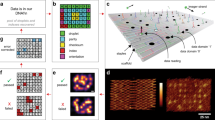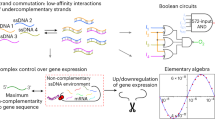Abstract
In this paper, we demonstrate through a chemistry experiment that conformational addressing can be achieved using the hairpin structure of a DNA molecule. The hairpin structure made by single-strand DNA (ssDNA) self-hybridization is made into the address part of conformational addressing, and it is assumed that the memory is read by opening this hairpin. The hairpin is continuously arranged in order to divide the address by class. Reading a sub-address requires an appropriate input oligomer to be added, when the preceding hairpin has been opened. We investigated, through the chemistry experiment, whether it would be possible to open the hairpin by the addition of an input oligomer into a solution that contained a hairpin-formed ssDNA.
Access this chapter
Tax calculation will be finalised at checkout
Purchases are for personal use only
Preview
Unable to display preview. Download preview PDF.
Similar content being viewed by others
References
Adleman, L.: Molecular Computation of Solutions to Combinatorial Problems. Science 266, 1021–1024 (1994)
Zuker, M., Stiegler, P.: Optimal Computer Folding of Large RNA Sequences Using Thermodynamics and Auxiliary Information. Nucleic Acids Research 9, 133–148 (1981)
Uejima, H., Hagiya, M.: Secondary Strucure Design of Multi-state DNA Machine Based on Sequential Structure Transtions. In: submitted to the Ninth International Meeting on DNA Based Computers, DNA9 (2003)
Yurke, B., et al.: DNA-fuelled molecular machine made of DNA. Nature 406, 605–608 (2000)
Yan, H., Zhang, X., Shen, Z., Seeman, N.C.: A robust DNA mechanical device controlled by hybridization topology. Nature 415, 62–65 (2002)
Author information
Authors and Affiliations
Editor information
Editors and Affiliations
Rights and permissions
Copyright information
© 2004 Springer-Verlag Berlin Heidelberg
About this paper
Cite this paper
Kameda, A., Yamamoto, M., Uejima, H., Hagiya, M., Sakamoto, K., Ohuchi, A. (2004). Conformational Addressing Using the Hairpin Structure of Single-Strand DNA. In: Chen, J., Reif, J. (eds) DNA Computing. DNA 2003. Lecture Notes in Computer Science, vol 2943. Springer, Berlin, Heidelberg. https://doi.org/10.1007/978-3-540-24628-2_22
Download citation
DOI: https://doi.org/10.1007/978-3-540-24628-2_22
Publisher Name: Springer, Berlin, Heidelberg
Print ISBN: 978-3-540-20930-0
Online ISBN: 978-3-540-24628-2
eBook Packages: Springer Book Archive




